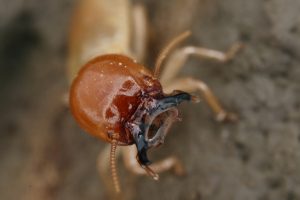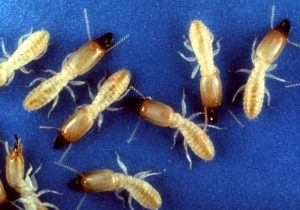
Termites are one of the insects that cause the most damage to homes around the world. In the United States, they cause billions of dollars in damages each year. Since termites actually chew through the wood, they can weaken the structure of your home and it is important to make repairs as quickly as possible. Here are four yard projects, you can do to
prevent your home from developing termites.
Clear Out Old Wood and Stumps
Termites like to eat old wood. If you have fallen trees in your yard or old tree stumps, you are practically sending out an invitation for termites to come into your yard, and when they have finished eating the old fallen trees, your home may become the next target. It is worth the extra effort to clear your home of old wood and branches. This can lower the chances of you having termite activity in your home. You may need to hire someone to come into take care of any stumps in your yard, but you should be able to clear up the rest.
Create a Cement Pad for Firewood
Stacking firewood directly against your home gives termites easy access to your home. They can crawl through it and up into your home. It is best to stack it away from your home. Putting in a cement pad to stack your wood on can add an extra layer of protection. The termites are less likely to find your firewood, and it gives you an additional layer of protection against termite activity. You can also cover the firewood to prevent it from getting termites or other insects in it. Then you do not need to worry about bringing termites in with your firewood.
Replace Old Wood Structures in Your Yard
If you are building any structures in your backyard, you will need to use treated wood. Your decks, sheds, and play structures all need to be built out of treated wood. Treated wood can last up to twenty years, but if your structure begins to show signs of damage it is important to replace it. If you have structures built without treated wood, you need to take steps to begin replacing those structures around your home.
Pay Attention to the Plant Beds Around Your Home
It is important to carefully plan and treat the ground that directly touches your home. Avoid using mulch in the flower beds that touch your foundation. Termites will eat the cellulose in the mulch and then move up to your home. If you have bushes or shrubbery around your home you need to keep it trimmed back so that it does not touch your home. The termites can crawl up the plants and access your home that way
Set Up Monitoring Stations Around Your Yard
There are monitoring stations that allow you to check for termite activity on your property. EcoTek has chemical free monitoring stations that are made up of wood, cardboard and cellulose. They check the stations quarterly and if there are signs of termite activity, they can begin to take the necessary steps to treat for termites.
If you notice signs of termites around your home, like long grooves in wood or mud tubes on your foundation, you should contact the experts at EcoTek to schedule a termite inspection and possible treatment.




 Termites are one of the insects that cause the most damage to homes around the world. In the United States, they cause billions of dollars in damages each year. Since termites actually chew through the wood, they can weaken the structure of your home and it is important to make repairs as quickly as possible. Here are four yard projects, you can do to prevent your home from developing termites.
Termites are one of the insects that cause the most damage to homes around the world. In the United States, they cause billions of dollars in damages each year. Since termites actually chew through the wood, they can weaken the structure of your home and it is important to make repairs as quickly as possible. Here are four yard projects, you can do to prevent your home from developing termites.
 There are a wide variety of termites in the United States. However, in the southeastern portion, the majority of termites are the Eastern Subterranean termites. These termites have different characteristics than other termites. It helps to understand their habits so you know the best treatment for the Eastern Subterranean Termite.
These termites build their colonies underground through a system of tunnels. They rarely have the termite mounds, so it can be difficult to spot one in your yard. These tunnels can extend several feet from the primary nests and allow the works to go and find food and bring it back to the colony.
Eastern subterranean termites prefer to eat dead wood. This means they may be eating old trees or tree stumps on your property. They may also go after wood piles, which is why you should never stack a wood pile against your home. They will also eat the wood inside of your home.
Since they are eating the wood inside of your home and eating along the grain of the wood, you may not notice them right away. If you do notice damage it will be in long grooves that go with the grain. Other signs that they are in your home include the mud tubes that they build up the side of your foundation until they can reach the wood of your home. These tubes are about the width of a pencil and if you see them, you need to deal with termites right away.
Subterranean termite colonies will travel in search of more wood to eat. In addition to sending out winged termites to start new colonies, the entire colony will travel through tunnels to a new food source. Often the queen is carried by worker ants.
Termites are quite common in North Carolina and a termite study in 2008 showed that the average property in the state has about ten termite colonies in it. The key is to protect the termites from finding your home and making it their feeding ground. You can do this through several steps such as repairing leaky pipes, but the most effective thing is to monitor your property regularly and have a termite treatment if necessary.
There are a wide variety of termites in the United States. However, in the southeastern portion, the majority of termites are the Eastern Subterranean termites. These termites have different characteristics than other termites. It helps to understand their habits so you know the best treatment for the Eastern Subterranean Termite.
These termites build their colonies underground through a system of tunnels. They rarely have the termite mounds, so it can be difficult to spot one in your yard. These tunnels can extend several feet from the primary nests and allow the works to go and find food and bring it back to the colony.
Eastern subterranean termites prefer to eat dead wood. This means they may be eating old trees or tree stumps on your property. They may also go after wood piles, which is why you should never stack a wood pile against your home. They will also eat the wood inside of your home.
Since they are eating the wood inside of your home and eating along the grain of the wood, you may not notice them right away. If you do notice damage it will be in long grooves that go with the grain. Other signs that they are in your home include the mud tubes that they build up the side of your foundation until they can reach the wood of your home. These tubes are about the width of a pencil and if you see them, you need to deal with termites right away.
Subterranean termite colonies will travel in search of more wood to eat. In addition to sending out winged termites to start new colonies, the entire colony will travel through tunnels to a new food source. Often the queen is carried by worker ants.
Termites are quite common in North Carolina and a termite study in 2008 showed that the average property in the state has about ten termite colonies in it. The key is to protect the termites from finding your home and making it their feeding ground. You can do this through several steps such as repairing leaky pipes, but the most effective thing is to monitor your property regularly and have a termite treatment if necessary.